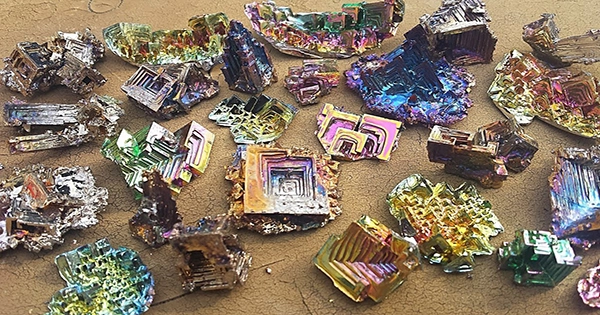Mother Nature took ages to create the stunning crystals and geodes we see in museums, but there is a way to do it yourself that is both faster and less expensive. With a little heat and a versatile little metal, you can manufacture stunning crystals and even geodes right in your kitchen. To the universe of bismuth crystals, welcome. What exactly is bismuth? Bismuth is a metal that occurs naturally and has certain unique features. It is the most naturally diamagnetic element: when it is exposed to a magnetic field, it forms an internal induced magnetic field that repels.
It also has one of the lowest thermal conductivities of any metal, making it a poor heat conductor. It has a melting point of 271.5 degrees Celsius (520.7 degrees Fahrenheit), which is low enough to be obtained in a kitchen.
The metal has been known since antiquity and was formerly thought to be the heaviest non-radioactive element until the discovery of radioactivity. However, it was discovered in 2003 that it was only very faintly radioactive. It has a half-life of almost a billion times that of the Universe, which is 19 billion years. So, unless you want to live forever, bismuth is exceedingly safe and stable in any use. It’s so safe that we’re pretty sure most of us have tried it.
WHAT IS THE PURPOSE OF BISMUTH? Don’t worry, it hasn’t been drunk as molten metal (which we don’t advocate because you’ll die). People consume it in the form of Bismuth subsalicylate, an antidiarrheal that is also an active ingredient in medications like Pepto-Bismol and Kaopectate, which are used to treat heartburn, indigestion, upset stomach, and nausea.
It has numerous medical applications in compounds, as well as being used in solders and other alloys in place of lead, because to their similar densities. Then there are the aesthetic possibilities. Bismuth oxides are iridescent, reflecting light with a color spectrum that is fractured. Bismuth crystals are widely purchased and made.
BISMUTH CRYSTALS: HOW TO MAKE THEM AT HOME, The procedure of creating crystals is really simple. You purchase a bismuth ingot and melt it in a pot (the one you dislike) while wearing safety goggles and leather gloves. The deeper and narrower it is, the better the results because you won’t expose too much of the molten metal to air, which would oxidize it and leave it unusable. The air will only have a role in the last step.
Turn off the heat after your bismuth is entirely liquid. After then, you’ll have to play the waiting game. Your liquid’s surface will start to harden in huge pieces. A crystal is growing beneath those bits; when you feel it’s ready, take one up with tweezers and watch the silvery surface turn multicolored as a thin layer of oxidization forms. If you want to be a little more creative, you may use molds to make everything from odd colored forms to bismuth geodes.














